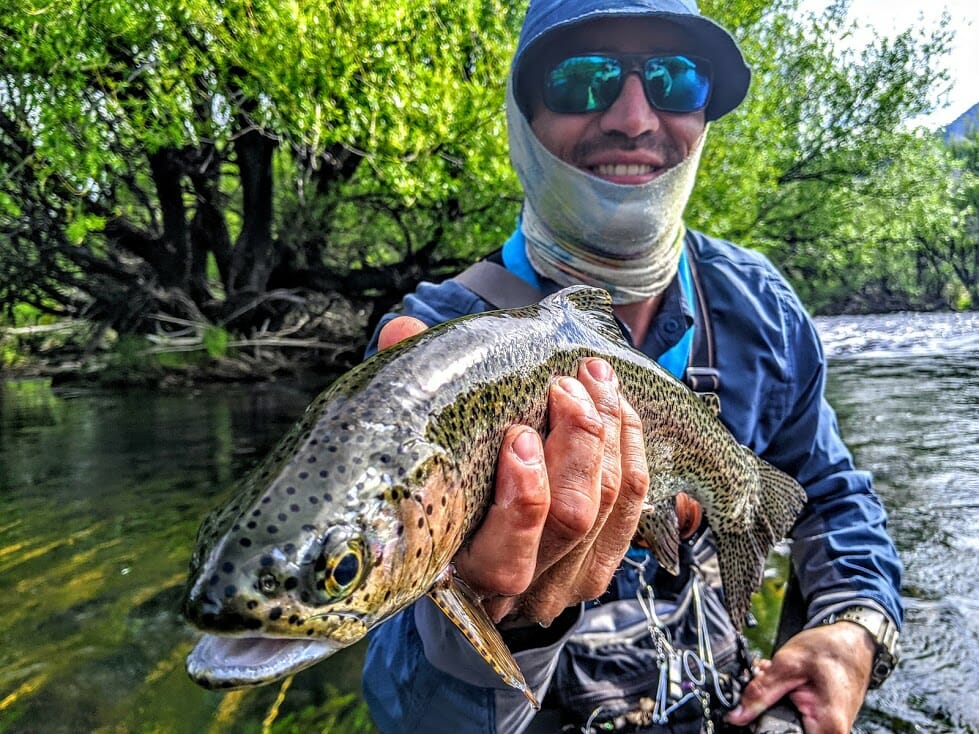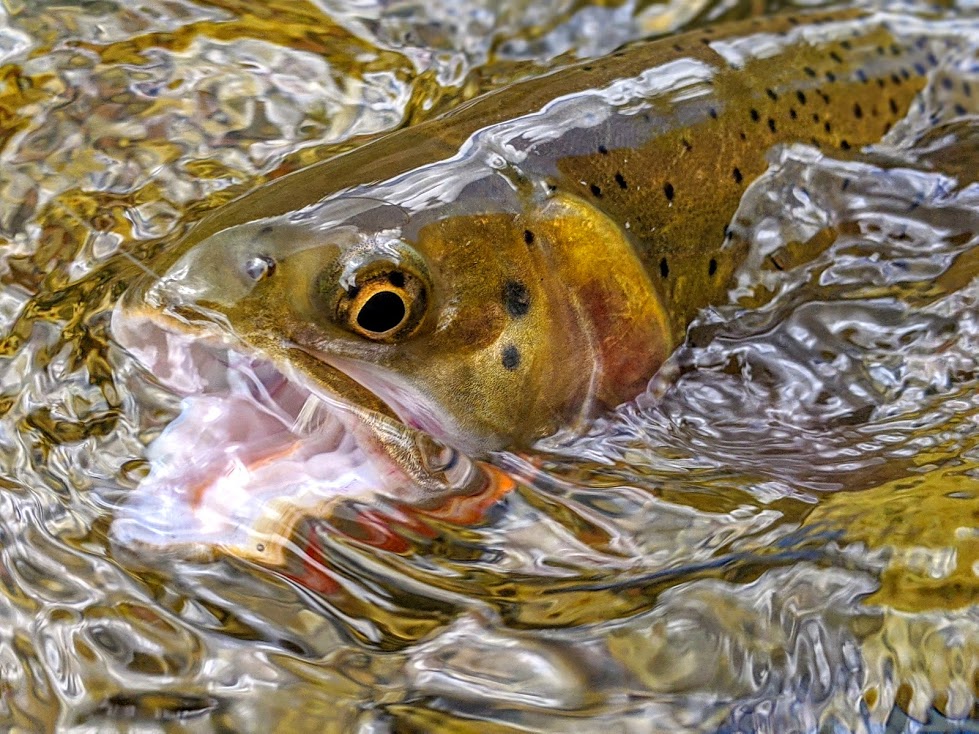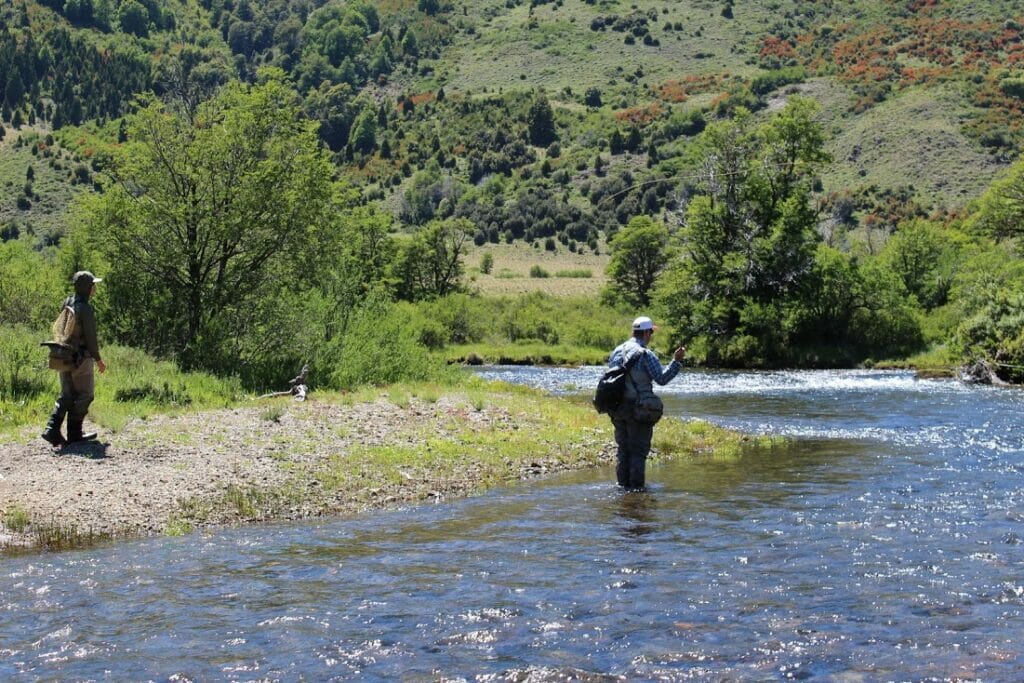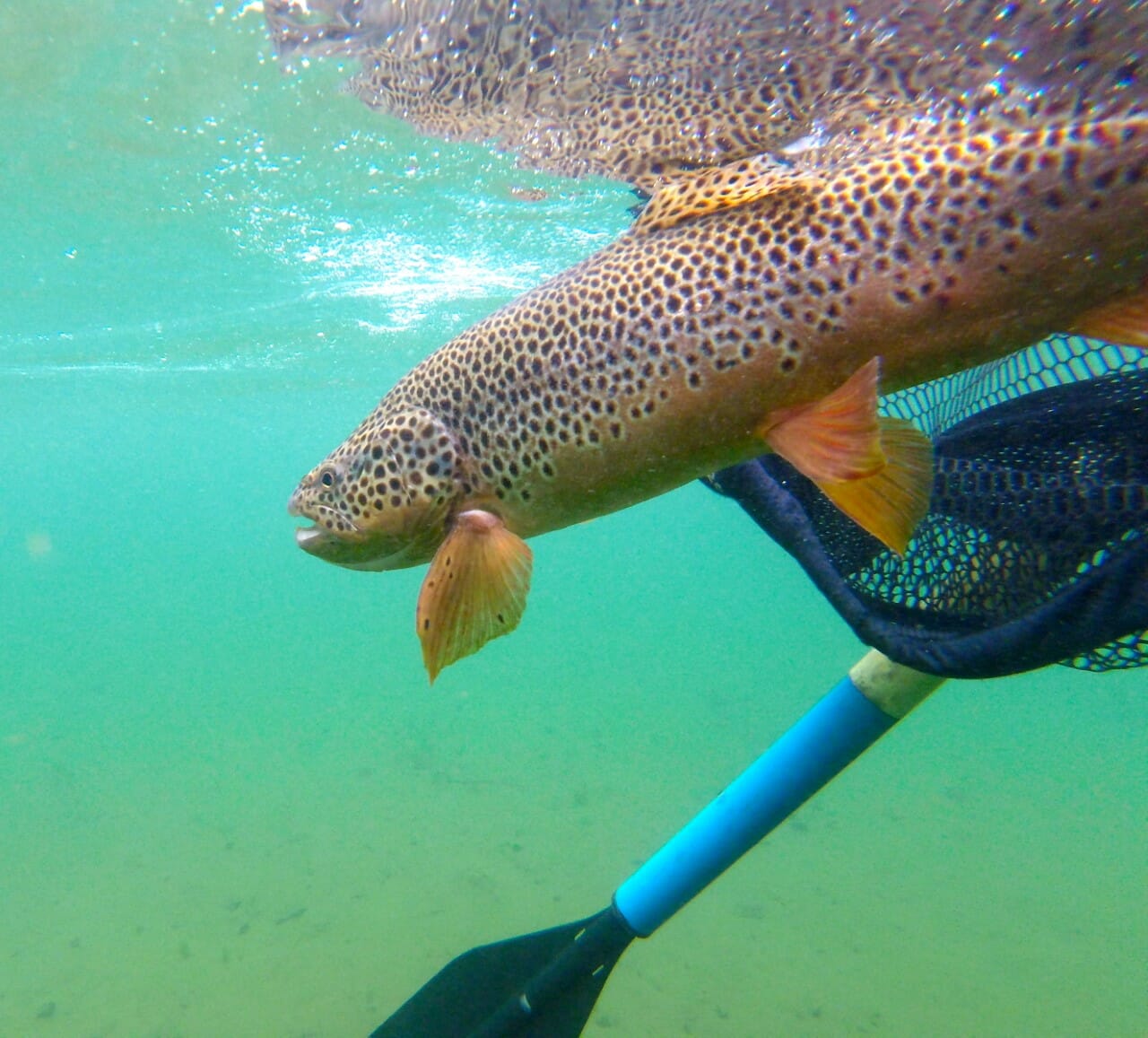Releasing a nice brown trout back into the river. Kirk Deeter photo.
Is catch-and-release angling overrated?
It is if the only thing that matters is numbers of fish caught…
In 1936, the late, great Lee Wulff said, “game fish are too valuable to be caught only once,” and the “catch-and-release” movement was born.
I’m a catch-and-release angler, at least when it comes to trout. I haven’t kept a trout for 20 years or more, but please don’t construe that as a fly-fishing “virtue signal” on any level. The honest truth is that I don’t like to eat trout, and I especially don’t like cleaning them. I just like tricking them with a fly and pulling on them. If I can pay that forward and let another like-minded angler experience the same, great—I’m all for that. And if my fascination with sticking a sharp object in the mouth of a fish and pulling them around for a bit makes you think I have a twisted soul, I’m fine with that, too.
For the record, I don’t have a problem at all with anglers who do like to eat trout, so long as they’re operating within the rules of the river. In fact, I find it curious when something as simple as an advertisement for a Panther Martin lure with a treble hook (page 93 of the current issue of TROUT magazine) gets some readers fired up enough to think that somehow TU is losing its conservation conscience by including such a ghastly product in its pages!
To be clear, if you are a catch-and-release angler, treble hooks are most definitely bad, because they damage the fish far more than a single, barbless hook. But certainly not every trout angler is obligated to embrace catch-and-release, and some of the most ardent “conservationists” I know like to catch a couple on gear and smoke them on the grill. I really believe TU needs to make the tent bigger and more inclusive.
Especially now.
On top of that, I think we need to take a really hard look at catch-and-release for what it really is… and what it is not… because I think the impacts of folks clearing their conscience and claiming “conservation” simply by dumping dozens of caught trout back in the river can sometimes have an even more negative impact, ultimately, than the angler who tucks a couple in the creel now and then.
Before we dive into that discussion, however, let’s back up and face another hard truth: some people have fundamental ethical issues with catch-and-release in the first place. Is catch-and-release really an exercise that allows fish to be tortured, over and over? Some countries mandate that a fish caught is dispatched, humanely, as quickly as possible, and they’ll make you take a class to figure out how to do that before they even issue you a fishing license.
I remember fishing with another editor/colleague from Field & Stream magazine, several years ago—he was primarily a hunting editor, and I was primarily fly fishing—and he had a real issue with catch-and-release fishing. He explained it as kind of like “paintballing elk or deer,” which in any jurisdiction of any wildlife agency in America would, of course, be considered a major no-no.
I also remember long, thoughtful conversations with young native Alaskan students at the Bristol Bay Academy who had a really hard time understanding how catch-and-release wasn’t tantamount to “playing with your food.” I didn’t have all the answers then, and I don’t have one now.
There’s an even bigger issue when catch-and-release is seen as a cure-all, even though it’s only one tiny part of a much broader mosaic of issues that ultimately impact the survivability of caught fish.

To wit, if you catch a fish, lift it out of the water, take photos for a minute or more, effectively suffocating the fish in the process, what good is it that you dumped it back in the water?
Or, if you insist on fishing when water temps are warm, and the fish are stressed beyond survivability if you catch them, what good comes from putting the fish back in the water?
If you use a net or gloves that rub the protective slime off a fish… you’ve compromised that fish, right?
We also know that the longer you fight a fish, and the more stress it feels, the odds of survival diminish rapidly. So how about line-class “world records?” What good is it to stress a fish for an extra 20 minutes because you’re afraid to pull on it hard enough that you might break that leader that earns you a record? I think that’s silly.

Are you pinching down your barbs? How much worse is the treble hook, really, if you’ve sunk a single-barb deep enough into a trout’s mouth that it takes five minutes and some mighty twists with forceps to root it out?
The point I’m making is that there are dozens of factors that influence how effective catch-and-release really is, and how much it’s only window dressing.
Even done well, we know caught-and-released fish die. Is the real mortality rate 10 percent? Five percent? All the factors mentioned above (and others) influence that. I was just fishing the Cheeky “Schoolie” striped bass tournament in Cape Cod, Mass., and as part of that, we got a really informative coaching lesson from Andy and Sascha Danylchuk about how to effectively handle and release caught fish.
You should visit www.keepfishwet.org to find the best science-based tips for making catch-and-release effective. I was most interested to learn that if we, as anglers, could merely endeavor to move the mortality rate of caught-and-released fish from 9 percent to 8 percent, among caught striped bass—just by paying attention to a number of details—that would equate to nearly 90,000 fish per year, still swimming in the ocean. I can’t even begin to imagine what the impact of good catch-and-release practices would really add up to in the trout, steelhead, and salmon realm.
All of that leads to the real elephant in the room, which nobody really wants to talk about.
But I will.
The pressure anglers are putting on fish and rivers is having a major, detrimental effect on fish populations and the fishing experience, right now. And it’s getting worse.
My friend Paul Vang put his thumb on it in reporting about the precipitous drop in fish counts of browns and rainbows on the Big Hole in Montana, where they’re now seeing 400 fish per mile, and a staggeringly lower number of mature year-class fish on one of the most respected, traditionally prolific wild fish ecosystems in North America.
Since 2008, angler days on the Big Hole have doubled to nearly 90,000 annually. And as the guy who coined “Rivergeddon” to describe the blowup we’ve seen across the country as a result of the pandemic, I can say that I literally cannot count the number of notes I’ve received from guides and other friends throughout the country who share the same story of how “hammered” the fisheries are now, and how that’s manifesting by way of fewer, smaller trout all around.
If the benchmark for success is a 20-fish day, and every guide across America has their never-ever (and will never again) clients staring at strike indicators all day long, because that’s the only way they can get them to pull on 20 or more fish and thus be successful… we’re in trouble.
On the one hand, the influx of newbies and re-lit anglers can be wonderful. More voices, more money, more advocacy, more political clout to be applied to rivers can be great.
But there are only so many cookies in the cookie jar.
And Trout Unlimited can do really cool things to restore habitat and build fish populations. But TU isn’t in the miracle business. And if you think, “just stock more fish,” well that runs counter to everything TU was created for in the first place.
I’ve been thinking long and hard about this (maybe you can tell) and I think the only way out at this point is to try to encourage anglers to catch a few fish. A few.

If the benchmark for success is a 20-fish day, and every guide across America has their never-ever (and will never again) clients staring at strike indicators all day long, because that’s the only way they can get them to pull on 20 or more fish and thus be successful… we’re in trouble.
I know… “how many” and “how big” are the only questions that have mattered in fishing for centuries. Trying to shift that paradigm is going to be harder than pushing water uphill.
But I do think we’re at a tipping point.
Oh, I can hear it already… “You’re not going to tell me how to fish! Or how many fish I can catch!”
That’s fine. You’re right. I’m not going to tell you how to fish, or how many fish to catch and let go.
But someone else most likely will. Just watch what’s already happening
On the Deschutes in Oregon, you cannot fish out of a drift boat. Similar things are happening on the Olympic Peninsula in Washington. In Colorado, they just closed the Yampa below Stagecoach Reservoir because flows are so low, Colorado Parks & Wildlife doesn’t trust anglers to take it easy on the fish. In May. That’s incredible.
The bottom line is that our river resources are pressured harder now than ever, and manufacturers, fly shops, guides… outfitters… anglers at large… if you don’t want this sport to be a Dust Bowl in five years—East or West—you need to start playing the long game.
When Lee Wulff talked about catch-and-release, it was a different time… a different type of fishing.
We need to be smarter. Especially now. If it’s about sharing, and if sharing is part of conservation, we must look at the whole picture.
Do it all. Follow all the best catch-and-release practices. And endeavor to find wonder in catching a few now and then, as you take in the full experience of all that’s around you.
The future of trout fishing literally depends on that.



